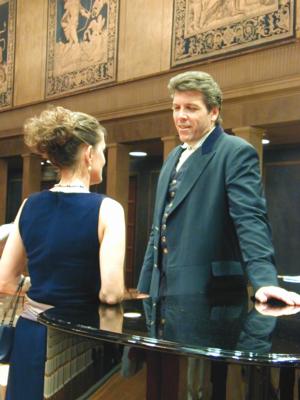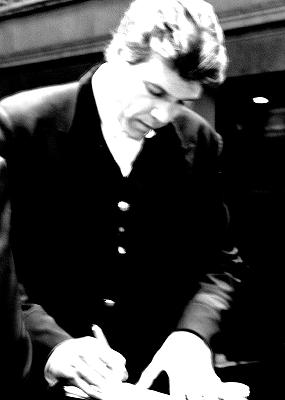|
<< -- 4 -- Sissy von Kotzebue AN EVENING FULL OF HAMPSONGS

In the second part, Hampson leads us into the world of Richard Strauss. He begins with Himmelsboten, one of the composer's few arrangements of the Wunderhorn poems. A typical Strauss composition, this Lied exhibits orchestral melodic aspects coupled with vivid onomatopoeia. When it comes to the description of the beloved with 'yellow hair' and 'little eyes clear' the key changes into a bright E major. Strauss preferred this key that he always uses to depict the erotic relationship between men and women. Hampson can again show off his lyric timbre as well as his deep understanding of the (German!) text. The high notes especially, often in pianissimo, prove his extraordinary talent and technique, going far beyond the normal range of a baritone.
Die Nacht, written by Strauss at only eighteen years old, is an object of fear for many singers because it has long phrases, difficult articulation, and a strange last note, a so called Trugschluss (false conclusion). Hampson performs it at a rather slow tempo, even more difficult to sing, and very calmly. Subtly, he increases the passion by apparently oppressing it.
As the final song of the recital, Hampson and Rieger chose Morgen. Strauss said that apart from his wife, the soprano Pauline de Ahna, he had never heard another singer capable of singing this with the kind of expression and poetic phrasing that he envisioned when writing it. He did not know Thomas Hampson. Standing high and straight, head majestically raised during the prelude, he sings that piece with so much expression that Strauss would be clapping in his grave if he knew. When Hampson closes his eyes at the end and bows his head, nobody dares to clap. Such is his command of the music. Hampson and Rieger have stunned and silenced. Only when the singer looks up again into the audience, after endless seconds of being lost in a land of musical perfection, the applause and bravos break over the two men.
Three encores and many minutes of applause and ovations later, Hampson addresses his public. 'The discussion about a crisis in classical music is something this audience does not know of, obviously. I am very touched to be here, in this beautiful hall, with you, but now -- it's over.' He speaks, grabs Rieger, and walks off stage with him. Those who want more, which is everyone present, will now need to travel to Salzburg to see these two: in the month of August, they have several performances there and also at the Attersee festival.

Thomas Hampson in conversation with a member of the audience. Photo © 2004 Sissy von Kotzebue
|
After the concert, the American baritone with the Sir Lancelot touch kindly takes time to give autographs to his fans, send a few women swooning, and converse with some old friends backstage. This persistent journalist, dreaming of a Hampson feature liberally sprinkled with quotes, is fed with hope for a lengthy interview: He says that he hopes to see her in Salzburg at the festival, where he will stay for a longer period and have time for interviews. With a kiss on the hand of the blushing journalist he vanishes, leaving the Herculean tapestries on the marble walls as a pale reflection of our hero of the opera.

Thomas Hampson signing autographs. Photo © 2004 Sissy von Kotzebue
|
|

